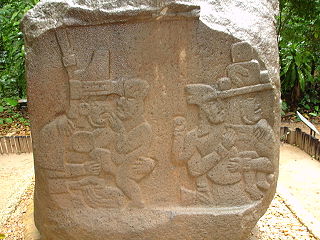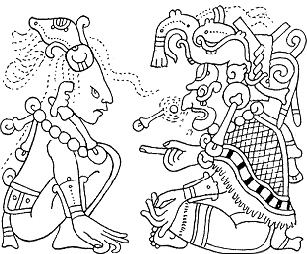
Xibalba, roughly translated as "place of fright", is the name of the underworld in Maya mythology, ruled by the Maya death gods and their helpers. In 16th-century Verapaz, the entrance to Xibalba was traditionally held to be a cave in the vicinity of Cobán, Guatemala. Cave systems in nearby Belize have also been referred to as the entrance to Xibalba. In some Maya areas, the Milky Way is viewed as the road to Xibalba.

In Maya mythology, Camazotz is a bat god. Camazotz means "death bat" in the Kʼicheʼ language. In Mesoamerica, the bat is associated with night, death, and sacrifice.

The Maya Hero Twins are the central figures of a narrative included within the colonial Kʼicheʼ document called Popol Vuh, and constituting the oldest Maya myth to have been preserved in its entirety. Called Hunahpu[hunaxˈpu] and Xbalanque[ʃɓalaŋˈke] in the Kʼicheʼ language, the Twins have also been identified in the art of the Classic Mayas. The twins are often portrayed as complementary forces. The complementary pairings of life and death, sky and earth, day and night, Sun and Moon, among multiple others have been used to represent the twins. The duality that occurs between male and female is often seen in twin myths, as a male and female twin are conceptualized to be born to represent the two sides of a single entity.
Xquic is a mythological figure known from the 16th century Kʼicheʼ manuscript Popol Vuh. She was the daughter of one of the lords of Xibalba, called Cuchumaquic, Xibalba being the Maya underworld. Noted particularly for being the mother of the Maya Hero Twins, Hunahpu and Xbalanque, she is sometimes considered to be the Maya goddess associated with the waning moon. However, there is no evidence for this in the Popol Vuh text itself.
Hun Hunahpu, or 'Head-Apu I' is a figure in Mayan mythology. According to Popol Vuh he was the father of the Maya Hero Twins, Head-Apu and Xbalanque. As their shared calendrical day name suggests, Head-Apu I was the father of Head-Apu. He is believed to be the father of the twins' half-brothers and the patrons of artisans and writers, Hun-Chowen and Hun-Batz. Head-Apu I is paired with his brother, Vucub-Hunahpu, Head-Apu VII. The brothers were tricked in the Dark House by the lords of the Underworld (Xibalba) and sacrificed. Head-Apu I's head was suspended in a trophy tree and changed to a calabash. Its saliva impregnated Xquic, a daughter of one of the lords of Xibalba. She fled the Underworld and conceived the Twins. After defeating the Underworld lords, the twins recovered the remains of their father and their father's brother, but could not resuscitate them.

Bolitoglossa is a genus of lungless salamanders, also called mushroom-tongued salamanders, tropical climbing salamanders, or web-footed salamanders, in the family Plethodontidae. Their range is between northern Mexico through Central America to Colombia, Venezuela, Ecuador, Peru, northeastern Brazil, and central Bolivia. Neotropical salamanders of the Bolitoglossa make up the largest genus in the order Caudata, consisting of approximately one-fifth of all known species of salamanders. Adult salamanders range anywhere from 45mm to 200mm in length depending on their specific species. They are notorious for their ability to project their tongue at prey items, as indicated from their name. They are also known for their webbed feet, having significantly more webbing than any other species outside their genus with the exception of the cave-dwelling Mexican bolitoglossine Chiropterotriton magnipes. Although webbed feet are a common characteristic of these salamanders, only about half of the species in this genus contain webbed feet.
Bolitoglossa borburata is a species of salamander in the family Plethodontidae. It is endemic to Venezuela. Its natural habitat is subtropical or tropical moist montane forests. It is also known as the Carabobo mushroomtongue.
Bolitoglossa engelhardti is a species of salamander in the family Plethodontidae. It is found in the extreme south-eastern Chiapas, Mexico, and eastward along the Pacific versant to Volcán Atitlán in south-western Guatemala. It is named for Teodoro Engelhardt, Guatemalan plantation owner who entertained Karl Patterson Schmidt and his expedition. Its common names include Engelhardt's salamander, Engelhardt's mushroomtongue salamander, and Engelhardt's climbing salamander.

Savage's salamander, also known as Savage's mushroomtongue salamander, is a species of salamander in the family Plethodontidae. It is endemic to the Sierra Nevada de Santa Marta in northern Colombia. The record from Venezuela represents another species, likely Bolitoglossa guaramacalensis. The species is named after Jay M. Savage, an American herpetologist.

The Maya death gods, known by a variety of names, are two basic types of death gods who are respectively represented by the 16th-century Yucatec deities Hunhau and Uacmitun Ahau mentioned by Spanish Bishop Landa. Hunhau is the lord of the Underworld. Iconographically, Hunhau and Uacmitun Ahau correspond to the Gods A and A'. In recent narratives, particularly in the oral tradition of the Lacandon people, there is only one death god, who acts as the antipode of the Upper God in the creation of the world and of the human body and soul. This death god inhabits an Underworld that is also the world of the dead. As a ruler over the world of the dead, the principal death god corresponds to the Aztec deity Mictlantecuhtli. The Popol Vuh has two leading death gods, but these two are really one: Both are called "Death," but while one is known as "One Death," the other is called "Seven Death." They were vanquished by the Hero Twins.
Jonathan Atwood Campbell is an American herpetologist. He is currently professor of biology at University of Texas at Arlington. He was a distinguished professor and chair of the Department of Biology, University of Texas at Arlington, Arlington, Texas.

The Book of Life is a 2014 American 3D computer-animated musical fantasy comedy film produced by 20th Century Fox Animation and Reel FX Animation Studios, and distributed by 20th Century Fox. Co-written and directed by Jorge R. Gutierrez, it was produced by Aaron Berger, Brad Booker, Guillermo del Toro, and Carina Schulze. It features the voices of Diego Luna, Zoe Saldana, and Channing Tatum with supporting roles by Christina Applegate, Ice Cube, Ron Perlman, and Kate del Castillo. Based on an original idea by Gutierrez, the story follows a bullfighter who, on the Day of the Dead, embarks on an afterlife adventure to fulfill the expectations of his family and friends.
Xibalba is an American hardcore punk band from Pomona, California, formed in 2007. The band plays hardcore with influences from death metal and doom metal, with lyrics in English and Spanish. Their debut album, Madre Mia Gracias Por Los Dias (2010) was released through A389 Recordings. Their second album, Hasta La Muerte (2012), was released by Southern Lord.

Madre mía gracias por los días is the debut album by the hardcore band Xibalba, originally released in 2010 by the band itself and Beatdown Hardware Records. Later, re-released on June 21, 2011 by A389 Recordings and Southern Lord Recordings.







